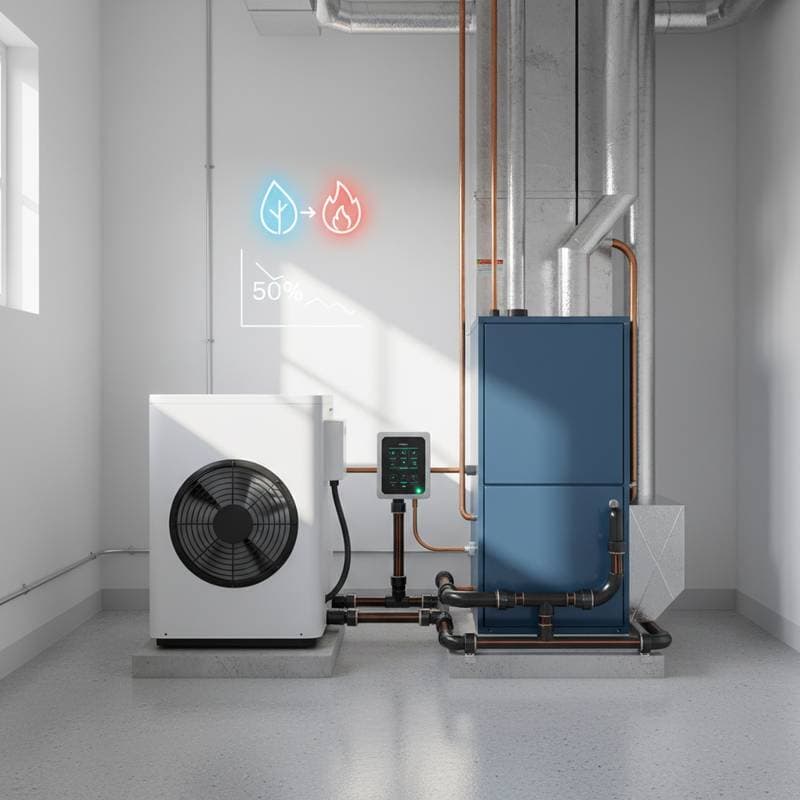Why Dual-Fuel HVAC Systems Excel in 2025 Heating
Homeowners often face challenges in achieving both efficiency and comfort as temperatures fluctuate. Heat pumps may falter during cold snaps, while gas furnaces increase energy costs on milder days. In regions with variable weather, dual-fuel systems provide a reliable solution by integrating heat pump efficiency with furnace reliability, ensuring predictable bills and consistent warmth.
Challenges of Traditional Heating Systems
Standard furnaces or electric heat pumps struggle in areas with significant temperature variations. Heat pumps perform well in moderate conditions but lose efficiency below freezing temperatures. Furnaces deliver robust heat yet consume fuel unnecessarily during milder weather, resulting in higher expenses and energy waste.
Homeowners frequently adjust thermostats or use supplemental heaters, leading to inconsistent comfort and accelerated equipment wear. Dual-fuel systems address these issues by combining technologies that automatically select the optimal heating method based on outdoor conditions.
How Dual-Fuel Systems Provide Intelligent Heating
A dual-fuel HVAC system pairs a heat pump with a gas or propane furnace. The heat pump extracts heat from outdoor air using electricity during moderate temperatures. When conditions turn colder, the system shifts to the furnace for reliable performance.
This integration suits homes in transitional climates with cold winters that do not reach extremes. It reduces reliance on a single energy source, allowing the system to prioritize electricity or gas as needed for maximum efficiency.
Mechanics of a Dual-Fuel HVAC System
Dual-fuel systems operate through coordinated components that respond to environmental cues.
-
Moderate Temperatures: The heat pump activates, transferring ambient heat indoors with minimal electricity use compared to resistance heating.
-
Low Temperatures: At a predetermined outdoor threshold, typically around 30 degrees Fahrenheit, the furnace engages to maintain steady indoor heat.
-
Cooling Mode: The heat pump reverses to cool the home efficiently during warmer months.
A smart thermostat or control board manages these transitions, eliminating manual intervention.
Primary Advantages of Dual-Fuel Heating
These systems deliver multiple benefits for homeowners prioritizing savings and sustainability.
-
Superior Efficiency: The setup employs the most economical energy source at all times. Heat pumps produce up to three units of heat per unit of electricity in suitable conditions.
-
Reduced Costs: Switching to the heat pump during mild weather lowers expenses by 20 to 40 percent versus a standalone furnace.
-
Lower Emissions: Greater use of electricity throughout the year decreases fossil fuel dependence and carbon output.
-
Reliable Comfort: Seamless operation prevents temperature fluctuations and ensures even heating.
-
Longer System Life: Balanced usage reduces strain on individual components, prolonging overall durability.
Strategies to Optimize Dual-Fuel Performance
Professional adjustments enhance the effectiveness of dual-fuel installations.
-
Adjust Balance Points: Technicians calibrate the switchover temperature, often between 25 and 35 degrees Fahrenheit, to balance efficiency and comfort based on local weather patterns.
-
Select Advanced Thermostats: Wi-Fi models track usage patterns and enable remote adjustments for precise control.
-
Maintain Regularly: Inspect the furnace annually before winter and the heat pump before summer to improve efficiency by 10 to 15 percent.
-
Improve Home Sealing: Address drafts through insulation upgrades and duct repairs to support system performance.
-
Track Consumption: Built-in monitoring tools reveal usage trends, guiding behavioral changes for further savings.
Factors to Consider for Installation
Evaluate your current infrastructure and finances prior to upgrading. Installation costs range from $6,000 to $12,000, influenced by capacity, efficiency ratings, and duct modifications. Long-term energy savings typically recover the investment within five to seven years.
Assess local energy rates; low electricity costs amplify benefits. In regions with time-of-use pricing, programmable controls avoid peak charges.
Prioritize safety by hiring certified professionals skilled in gas connections, refrigerant management, and regulatory compliance. They ensure proper venting, air supply, and electrical setup.
Performance in Diverse Regions
Dual-fuel systems thrive in areas with moderate winters and variable summers. Southeastern residents leverage heat pumps year-round, activating furnaces only during rare freezes. Northern households achieve cost reductions without compromising warmth.
A client reported halving winter gas expenses after installation. The system switches imperceptibly, yet the bill reductions are evident.
Steps to Implement Dual-Fuel Heating
Consult a qualified HVAC specialist to evaluate your home and receive a customized quote. Focus on experts familiar with regional climates to set ideal balance points. Proper setup and ongoing care deliver sustained efficiency and comfort.
Frequently Asked Questions
How often should a dual-fuel HVAC system receive service?
Service the heat pump before summer and inspect the furnace before winter. Routine checks prevent failures and sustain optimal operation.
Is retrofitting an existing furnace with a heat pump feasible for dual-fuel?
Yes, compatibility assessments by technicians often allow this upgrade, including necessary control enhancements.



